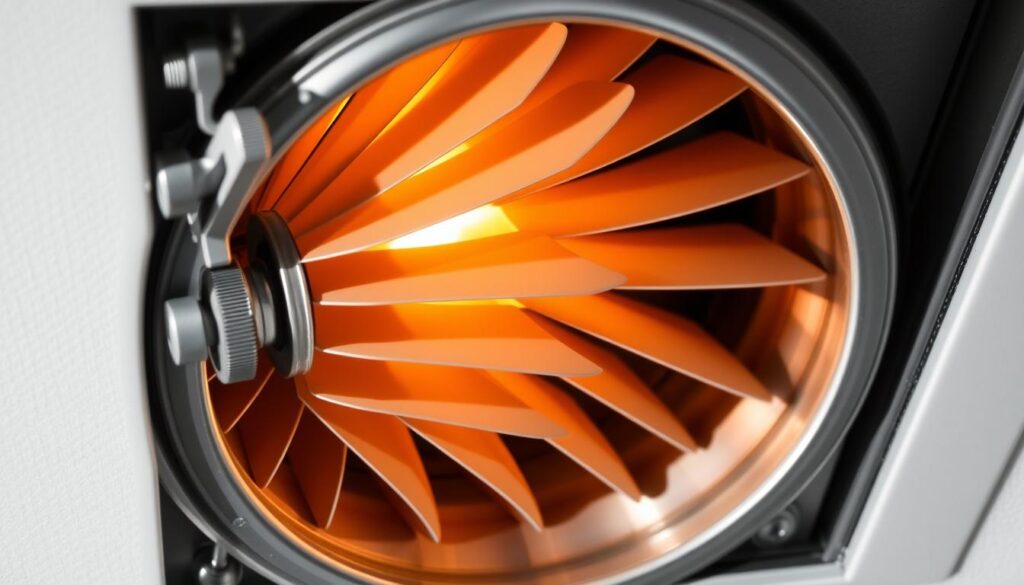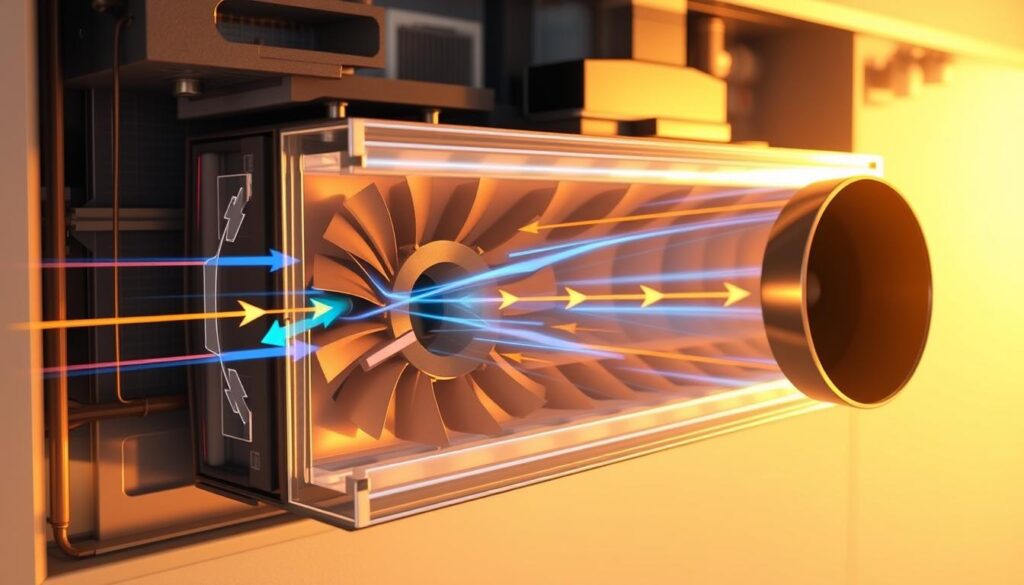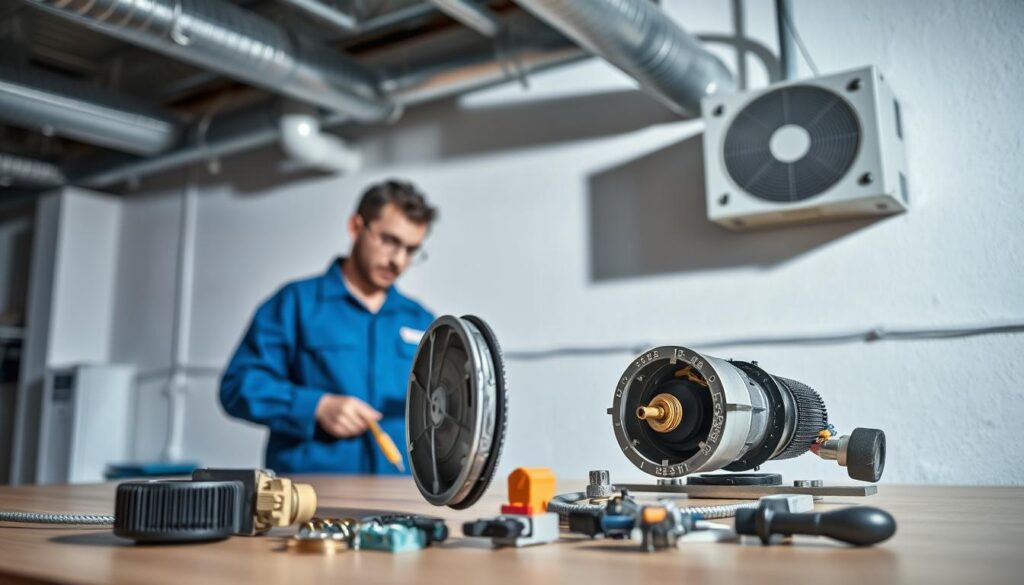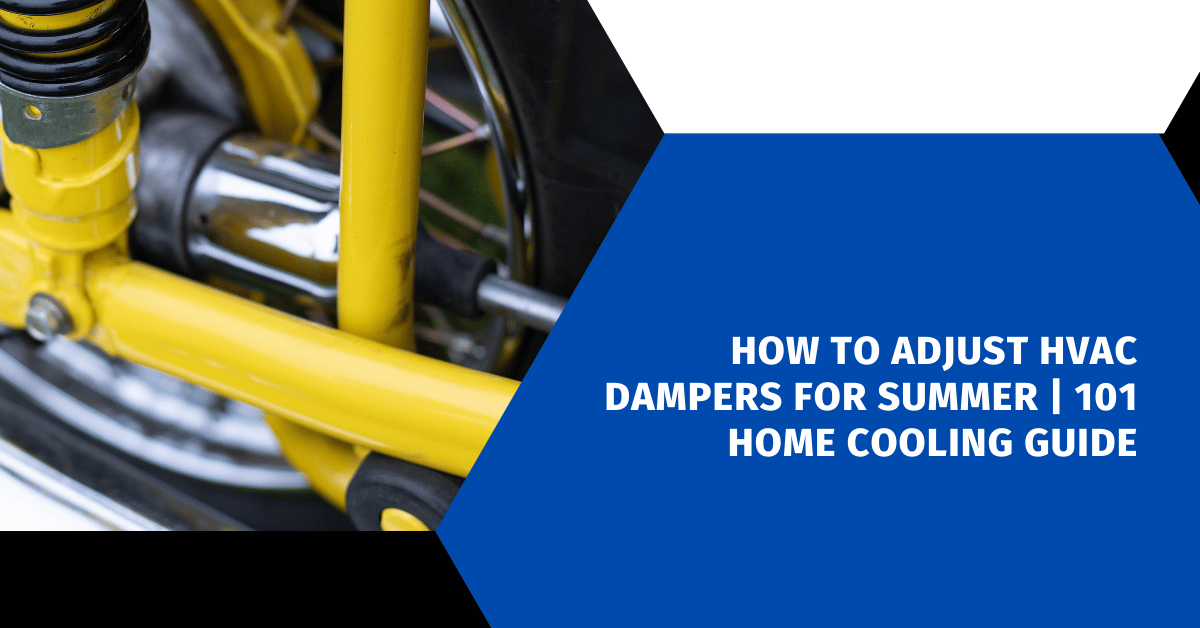Affiliate Disclosure
HVAC Guide Guys is a participant in the Amazon Services LLC Associates Program, an affiliate advertising program designed to provide a means for sites to earn advertising fees by advertising and linking to Amazon.
How to Adjust HVAC Dampers for Summer? Ever noticed how some rooms get freezing cold while others feel like a sauna in summer? The answer might be in your air ducts: HVAC dampers.

Adjusting your HVAC dampers for summer can make a huge difference in your home’s comfort. These small metal plates control air flow, sending cool air to the right places. Learning to adjust them is key to keeping your home cool and efficient.
Imagine controlling your home’s temperature zones perfectly. No more hot spots. With the right damper settings, you can achieve this balance.
Key Takeaways
- HVAC dampers regulate airflow throughout your home
- Proper adjustment can significantly improve cooling efficiency
- Summer settings differ from winter configurations
- Damper adjustments can help reduce energy costs
- Understanding your home’s unique airflow patterns is crucial
Table of Contents
Understanding HVAC Dampers and Their Role in Home Cooling
Your home’s cooling system is more complex than you might realize. HVAC dampers play a crucial role in balancing airflow in summer. They ensure every room receives optimal comfort. Think of them as intelligent traffic controllers for your home’s air circulation.
HVAC zoning for hot weather relies on these innovative devices. They manage temperature distribution effectively. They work silently behind your walls, creating a personalized cooling experience throughout your living space.
What Are HVAC Dampers?
HVAC dampers are adjustable plates installed within your ductwork. They control air movement. They function like valves, directing cool air precisely where you need it most. Key characteristics include:
- Precision air routing
- Temperature zone management
- Energy efficiency optimization
How Dampers Control Airflow
Dampers modify air distribution by opening and closing strategic passages. This mechanism allows you to customize cooling across different home areas. It prevents energy waste and ensures consistent comfort.
| Damper Type | Airflow Control | Best Used For |
|---|---|---|
| Manual Dampers | Direct physical adjustment | Single-story homes |
| Motorized Dampers | Automated temperature regulation | Multi-level residences |
Benefits of Proper Damper Adjustment
Correctly configured dampers provide significant advantages:
- Reduced energy consumption
- Enhanced indoor comfort
- Balanced temperature across rooms
- Extended HVAC system lifespan
By understanding and utilizing your HVAC dampers effectively, you can transform your home’s cooling strategy. Enjoy a more comfortable summer experience.
Explore Our HVAC Shop
Looking for top-rated HVAC tools, parts, and accessories? Visit our shop and find the perfect solution for your needs.
Visit the ShopTypes of HVAC Dampers for Summer Cooling
It’s important to know about the different HVAC dampers to boost your home’s cooling. These parts are key in adjusting ductwork for air conditioning. They help control airflow and keep your home cool during summer.
Your home’s HVAC system has various dampers for cooling. Each one is made for a specific purpose:
- Butterfly Dampers: Flat, circular dampers great for closing dampers in big ductwork systems
- Blade Dampers: Versatile for controlling airflow in different home zones
- Inlet Vane Dampers: Good for managing air intake and temperature
- Louver Dampers: Adjustable slat-style dampers for flexible airflow control
Choosing the right damper depends on your home’s layout and cooling needs. HVAC experts can guide you to find the best dampers for your system’s performance and energy use.
Proper damper selection can reduce energy consumption and improve overall home comfort during summer months.
Remember, each damper type has its own benefits. Your home’s design and HVAC setup will decide the best damper strategy. This ensures consistent, comfortable temperatures.
Locating Your Home’s HVAC Dampers
Finding your HVAC dampers is key to better air flow in your home. These parts help direct cool air exactly where you want it. It’s important for a comfortable home.
Dampers are found in your home’s ductwork. They control air flow, helping you adjust cooling in summer.
Common Damper Locations
- Main trunk lines before and after major junctions
- Horizontal and vertical duct intersections
- Near registers in different rooms or zones
- Basement and attic ductwork
Identifying Damper Controls
Dampers have a lever or handle for adjusting. You’ll find these controls:
- Near duct access points
- Inside mechanical rooms
- Close to HVAC equipment
- Behind removable vent covers
Signs of Damper Presence
Look for these signs of dampers nearby:
- Rectangular metal handles on ductwork
- Small access panels
- Visible mechanical linkages
- Slight protrusions in duct surfaces
Knowing where your dampers are lets you control your home’s cooling. With a little search, you’ll find these important parts.
Explore Our HVAC Shop
Looking for top-rated HVAC tools, parts, and accessories? Visit our shop and find the perfect solution for your needs.
Visit the ShopHow to Adjust HVAC Dampers for Summer
Adjusting your HVAC dampers for summer can make your home cooler. When it gets hot, it’s key to set your dampers right for comfy indoor air.
To adjust your HVAC dampers for summer, follow these steps:
- Find the main damper controls in your HVAC system
- Know which dampers control different parts of your home
- Open dampers for upper floors to let cool air flow
- Close dampers for basement and ground levels a bit
Pro tip: Cool air sinks, so placing dampers right helps direct air where it’s needed most in summer.
“Proper damper adjustment can cut cooling costs by up to 20% and boost home comfort.” – HVAC Professional Insight
When you adjust your summer hvac damper settings, keep these tips in mind:
- Check damper positions before summer heat hits
- Adjust manual damper controls gently
- Listen for airflow changes after adjusting
- Watch room temperatures to ensure even cooling
In multi-story homes, aim for balanced airflow. Upper floors need more open dampers to fight heat rising. Lower levels might need less airflow to keep temperatures steady.
Summer Damper Settings for Multi-Story Homes
Managing your home’s cooling system in a multi-story house is a big task. You need to set up hvac zoning for hot weather. This means adjusting dampers carefully to keep every level comfortable.
Different floors get hotter because heat rises. Your cooling plan must handle these temperature changes to keep everyone comfortable.
Upper Floor Cooling Strategies
Upper floors get hotter and need extra care in summer. Here are some important steps:
- Open dampers wider on upper levels
- Increase airflow to counteract heat buildup
- Redirect more cool air to top floors
Main Floor Temperature Management
The main living area needs balanced cooling. Focus on:
- Moderate damper settings
- Consistent airflow distribution
- Even temperature regulation
Basement Level Cooling Optimization
Basements stay cooler and need less cooling. Your damper settings should:
- Restrict airflow to basement areas
- Prioritize upper floor cooling
- Minimize unnecessary energy consumption
“Effective damper management is the key to efficient summer cooling in multi-story homes.” – HVAC Cooling Experts
Getting your damper settings right can make a big difference. It can improve your home’s cooling efficiency and comfort during hot summers.
Explore Our HVAC Shop
Looking for top-rated HVAC tools, parts, and accessories? Visit our shop and find the perfect solution for your needs.
Visit the ShopOptimizing Airflow Distribution for Maximum Cooling

To cool your home well, you need to manage airflow smartly. It’s not just about turning on the AC. Dampers play a big role in making your home cooler.
Using dampers to control airflow can cut down on cooling costs. Your HVAC system can cool your home better with the right damper settings. This makes your home more comfortable and saves energy.
- Identify rooms with inconsistent temperatures
- Check damper positions for each zone
- Balance airflow to eliminate hot spots
- Monitor energy consumption after adjustments
Think about making a strategic cooling map for your home. This map shows how cool air moves and stays in different rooms. Some rooms, like those facing the sun, might need extra cooling.
Proper damper adjustment can reduce your cooling expenses by up to 20% while improving overall home comfort.
Experts say it’s smart to check your airflow often. HVAC pros can adjust your dampers for better cooling and less energy use.
Signs Your Dampers Need Adjustment
To keep your home cool in summer, you need more than just air conditioning. Seasonal HVAC maintenance means knowing when your system needs help. Spotting signs that your dampers need adjustment helps keep your cooling efficient and avoids problems.
Your home’s comfort and energy use depend on working HVAC dampers. It’s key to adjust ductwork for air conditioning. This ensures balanced airflow and even temperatures everywhere.
Temperature Inconsistencies
Uneven cooling is a sign your dampers need adjusting. Look out for these temperature signs:
- Some rooms feeling much warmer than others
- Noticeable temperature differences between floors
- Persistent hot or cold spots in specific areas of your home
Airflow Issues
Weak or blocked airflow points to damper problems. Watch for:
- Weak air circulation from vents
- Rooms with little air movement
- Unusual whistling or rattling sounds from ductwork
Energy Bill Changes
Unexpected energy bill hikes can mean damper issues. Sudden cooling cost increases might mean your system is working too hard because of damper settings.
Pro tip: Regular seasonal HVAC maintenance can help you catch damper issues before they become costly problems.
Explore Our HVAC Shop
Looking for top-rated HVAC tools, parts, and accessories? Visit our shop and find the perfect solution for your needs.
Visit the ShopManual vs. Automatic Damper Systems
Understanding the difference between manual and automatic damper systems is key for managing your home’s cooling. Your choice affects comfort, energy use, and temperature control.
Manual systems need you to adjust them by hand. You must open or close dampers to change the temperature in your home’s zones. This method gives you direct control but requires more effort.
- Manual dampers require physical manipulation
- Direct control over individual room temperatures
- Lower initial installation costs
- More hands-on approach to home cooling
Automatic damper systems are more advanced for precise temperature control. They connect to your thermostat and adjust airflow based on your temperature settings.
| System Type | Control Method | Cost | Convenience |
|---|---|---|---|
| Manual Dampers | Physical adjustment | Lower | Low |
| Automatic Dampers | Thermostat-controlled | Higher | High |
Choosing the right damper system depends on your home, budget, and comfort needs. Automatic systems offer seamless temperature regulation but cost more. Manual systems are cheaper but need more effort from homeowners.
Troubleshooting Common Damper Problems

Seasonal HVAC maintenance is key to keeping your home cool. Dampers are vital for even air distribution. But, they can face issues over time.
Spotting common damper problems is crucial for efficient cooling. Here are some issues to look out for:
- Stuck or frozen damper blades
- Mechanical control mechanism failures
- Uneven airflow between rooms
- Excessive dust accumulation
- Corrosion or rust buildup
Spotting these problems early can avoid bigger HVAC issues. Watch for temperature changes or strange noises from your system.
| Problem | Potential Cause | Recommended Action |
|---|---|---|
| Blade Resistance | Mechanical wear | Lubricate moving parts |
| Irregular Airflow | Misaligned dampers | Professional realignment |
| Control Malfunction | Electrical issues | Check wiring connections |
Getting a pro to check your system during seasonal maintenance can fix damper issues. Regular checks keep your air cool and even in your home.
Expert Tip: Regular maintenance prevents 80% of common damper problems.
If you’re unsure, call an HVAC expert. They can find and fix specific problems with your air system.
Maintaining Your HVAC Dampers Year-Round
It’s important to keep your HVAC dampers in good shape. This helps your home stay cool and saves on energy costs. Regular HVAC maintenance is key to keeping your system running well all year.
Looking after your HVAC dampers can make your home more comfortable and energy-efficient. Knowing how to maintain them properly can cut down on cooling costs. It also helps your HVAC system last longer.
Essential Seasonal Maintenance Tips
- Inspect dampers for dust and debris quarterly
- Check damper seals and connections for any wear
- Lubricate moving parts to ensure smooth operation
- Clean surrounding ductwork to improve airflow
Professional Inspection Guidelines
While you can do some maintenance yourself, getting a professional check is also crucial. Experts say you should get a professional HVAC check at least once a year. It’s best to do this before the hottest or coldest months.
Long-Term Care Strategies
- Keep detailed maintenance records
- Replace air filters regularly
- Monitor system performance
- Address any unusual sounds or airflow issues promptly
By following these maintenance tips, your HVAC dampers will work better. This keeps your home at a comfortable temperature and saves on energy bills.
Explore Our HVAC Shop
Looking for top-rated HVAC tools, parts, and accessories? Visit our shop and find the perfect solution for your needs.
Visit the ShopCombining Damper Adjustment with Other Cooling Strategies
Using dampers to cut cooling costs is just the start. To really make your cooling system efficient, mix different strategies that work well together.
Optimizing central air distribution is more than just adjusting dampers. Think about these other cooling methods:
- Install ceiling fans to enhance air circulation
- Improve home insulation to minimize heat transfer
- Use smart thermostats for precision temperature control
- Apply window treatments to block solar heat
Ceiling fans can make your rooms feel 4 degrees cooler with little electricity use. Pairing them with adjusted HVAC dampers creates a strong cooling plan that cuts energy use.
Smart home tech adds another efficiency layer. Programmable thermostats adjust settings based on your schedule, working with dampers for the best comfort and less energy waste.
Good insulation is key against summer heat. Sealing leaks and adding insulation in attics and walls helps your HVAC system cool better. It also eases the damper’s work.
A holistic approach to home cooling can help you save up to 30% on your summer energy bills.
The best cooling strategy uses many techniques. Your HVAC dampers are a big help, but they’re even better with other energy-saving methods.
Conclusion
Learning how to adjust HVAC dampers for summer can change how cool your home feels. By setting your HVAC dampers right for summer, you make your home cooler and use less energy. It’s all about managing airflow to keep your home comfy.
Investing in learning how to adjust dampers is worth it. Homeowners who learn to adjust their HVAC systems save on energy, keep temperatures even, and cut cooling costs. It might seem hard, but with some effort, you can control your home’s climate better.
Adjusting dampers is not a one-time job. Every summer brings new cooling challenges. If you’re unsure, get help from a pro. Always think about your home’s cooling needs when adjusting your HVAC dampers.
Mastering HVAC damper adjustments for summer lets you make your home cooler and more efficient. By knowing your system and taking action, you can keep your home cool and comfy all summer long.

